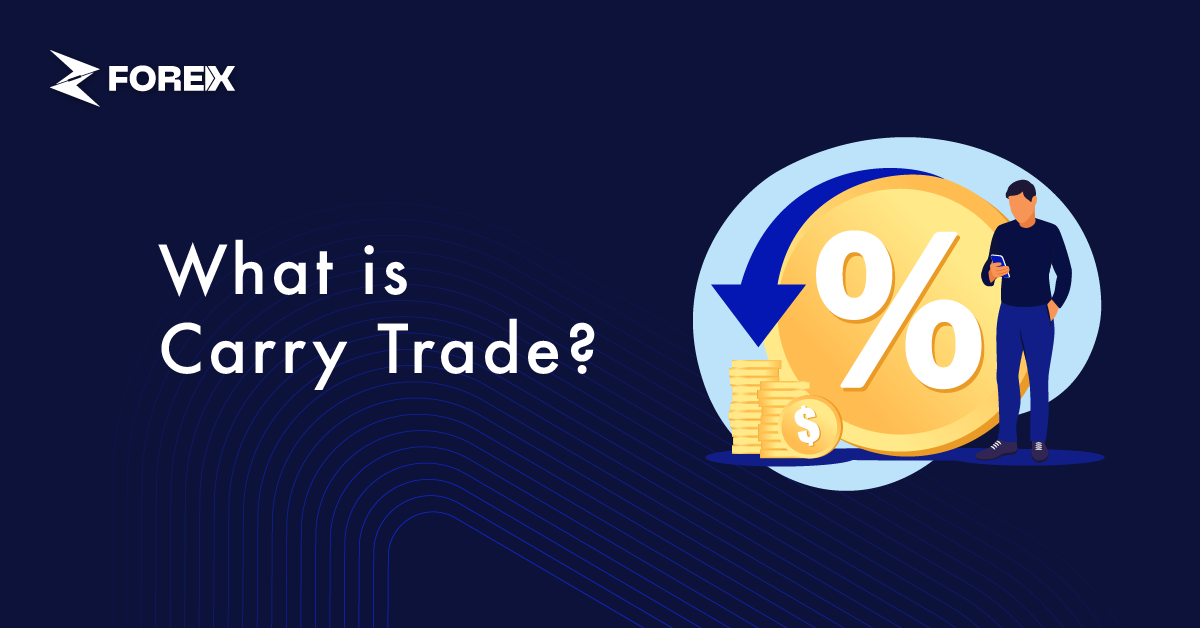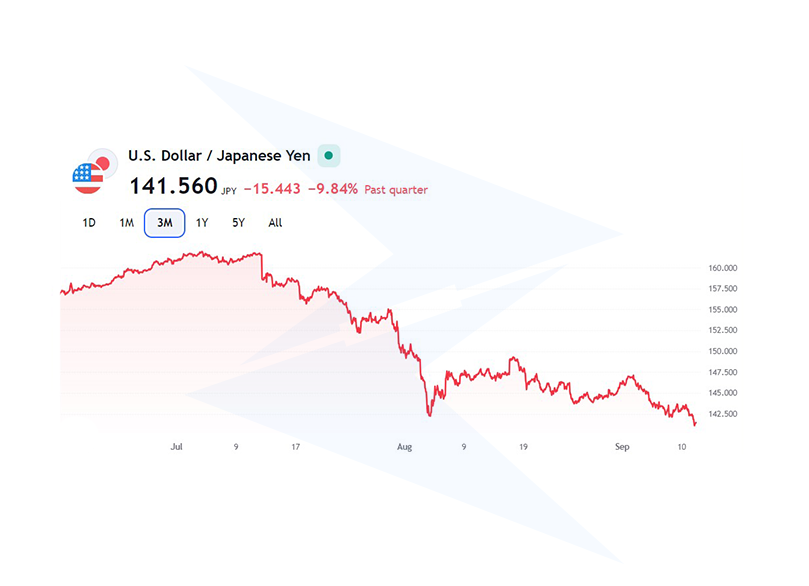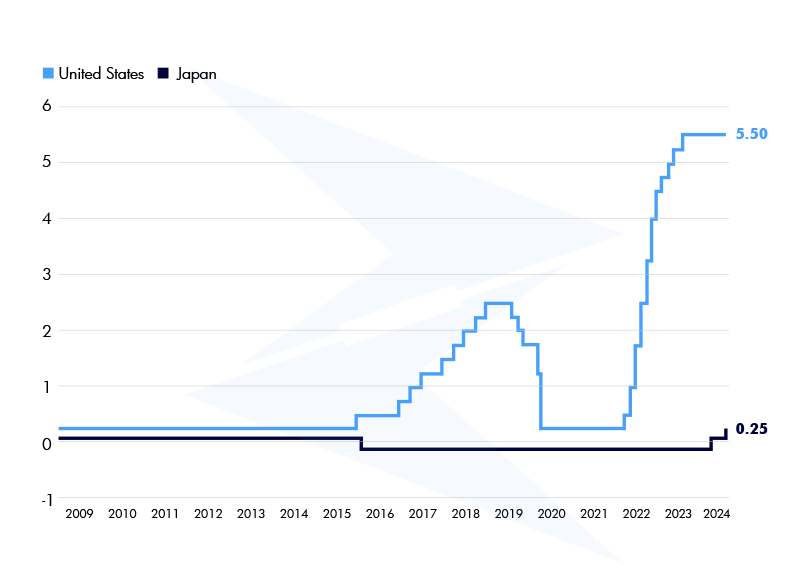
A carry trade is a popular investment strategy used by traders to take advantage of interest rate differences between two currencies. It’s a way to borrow money in a currency with a low interest rate and invest in another currency that offers a higher yield.
The goal? Profit from the difference in interest rates, also known as the “carry.”
Carry trades are particularly common in FX markets, where certain currencies (like the Japanese yen), often have much lower interest rates compared to others (like the U.S. dollar).
At its core, a carry trade is a straightforward concept, but it involves several moving parts that make it a bit more complex in practice. In simple terms, it’s about borrowing money in a low-interest-rate currency and investing it in a higher-interest-rate currency to pocket the difference in interest rates.
Investors borrow in the low-interest currency and invest in the higher-yielding one, collecting the interest rate difference over time.
While the concept sounds simple, there are key factors that make it work—and sometimes not work.
Let’s break it down further with some examples and key points:
The entire foundation of a carry trade is built on the difference between the interest rates of two currencies. For example, let’s say the Japanese yen has an interest rate of 0.1%, and the Australian dollar has an interest rate of 4%. An investor can borrow yen, which is essentially cheap money, and buy Australian dollars to earn the 4% yield. The difference (3.9%) becomes the investor’s profit.
It’s not just about interest rates. Currency values also fluctuate, which can either work in your favor or against you. For example, if you borrow Japanese yen to buy Australian dollars, and the Australian dollar appreciates, you not only earn from the interest differential but also from the currency movement. However, if the Australian dollar weakens, your carry trade could result in a loss.
Carry trade should not be considered as free money. Because there are transaction fees, spreads, and sometimes unexpected market shifts. For example, if geopolitical tension causes the yen to strengthen, your borrowed amount could suddenly become more expensive.
Carry trades often involve the use of leverage, which means borrowing more money than you own to amplify potential gains. For instance, if you have $10,000 but you borrow $50,000 to execute a carry trade, any profit is magnified.
Carry trades occur because of the differences in interest rates between countries.
When a central bank in one country maintains lower interest rates, while another country offers higher yields, traders and investors see an opportunity to profit from the gap. They borrow in the currency of the country with the lower rate and invest in the higher-yielding currency.
It’s a way for investors to earn passive income from interest payments while also potentially benefiting from favorable currency movements.

Both institutional and individual investors can benefit from carry trades. Large financial institutions, such as hedge funds and investment banks, often use this strategy on a much larger scale.
They employ leverage, which amplifies their potential returns by allowing them to borrow significant sums to take advantage of the rate difference. Retail traders also benefit, though on a smaller scale, by borrowing in low-interest currencies like the Japanese yen or Swiss franc and investing in higher-yield currencies like the Australian or New Zealand dollar.
These trades offer a way to earn regular returns in stable market conditions. However, these opportunities rely on the stability of interest rates and currency values.
Carry trades are commonly executed in currency pairs. Some currencies are frequently involved in carry trades due to their historically low or high interest rates.
Each of these trades involves borrowing in a low-interest-rate currency (like the Japanese yen or Swiss franc) and investing in a higher-yielding currency (such as the Australian dollar or Brazilian real). Let’s break down some real-world examples of these trades.
One of the most popular carry trades involves borrowing in Japanese yen (JPY), which has long had an ultra-low interest rate, and investing in Australian dollars (AUD), a currency associated with much higher interest rates.
For years, Australia’s strong economy and higher central bank rates attracted investors to this carry trade. The JPY/AUD carry trade offered the dual benefit of a high yield and relative currency stability. However, this trade became less profitable during economic downturns or when the yen appreciated.
Another well-known carry trade is borrowing in yen and investing in U.S. dollars (USD). The Federal Reserve's higher interest rates compared to Japan’s central bank made this trade attractive for many years, particularly in periods of U.S. economic expansion.
Investors could leverage the difference, profiting from both the interest rate spread and potential appreciation of the U.S. dollar. But this can quickly reverse if the yen strengthens or if U.S. interest rates drop.
The Swiss franc (CHF) is another currency that has consistently low interest rates, often in negative territory, making it a great funding currency. On the other hand, New Zealand dollars (NZD) have historically offered much higher yields.
Investors borrow francs to invest in New Zealand’s higher-yielding assets.
The euro (EUR) and Brazilian real (BRL) pair represents a more volatile but potentially lucrative carry trade. Borrowing in euros, where interest rates have been lower due to the European Central Bank’s monetary policies, and investing in Brazilian assets, which offer high yields, has been an attractive option for risk-tolerant investors.
This trade has delivered strong returns during periods of economic stability in Brazil.
In early 2024, something significant occurred in the world of carry trades: The unwinding of the Japanese yen carry trade.
For years, investors had borrowed in Japanese yen (JPY) at near-zero interest rates to invest in higher-yielding currencies. This strategy worked well as long as Japan maintained its extremely low interest rates.

However, in 2024, a combination of rising interest rates in Japan and growing global economic uncertainty led many investors to reverse these trades—known as "unwinding." As Japan's central bank hinted at tightening its monetary policy to combat inflation, the yen started appreciating rapidly.
Investors, who had borrowed in yen, were suddenly faced with the increasing cost of repaying their loans in the now stronger currency. As a result, they began selling off their higher-yield assets (like USD or AUD) and buying back yen to settle their positions. This situation led to a sharp appreciation of the yen and a drop in higher-yielding currencies.
This unwinding caused high volatility in the forex markets. Investors with large leveraged positions were especially hit hard, as the yen’s strength reduced the value of their positions.
The 2024 Japanese Carry Trade Unwinding serves as a reminder of the risks associated with carry trades, especially in an environment where central bank policies can shift unexpectedly.
What are the risks related to carry trades?
Carry trades carry several risks, including currency fluctuations, changes in interest rates, and market volatility. Sudden shifts in currency values or central bank policies can quickly turn a profitable carry trade into a loss. Investors using high leverage are particularly vulnerable.
What are the differences between theory vs. practice in carry trades?
In theory, carry trades seem straightforward: borrow in a low-interest currency and invest in a higher-yielding one. In practice, however, things like transaction costs, currency volatility, and unexpected market events make carry trades riskier and more complex than they appear on paper.
What is the unwinding of carry trades?
Unwinding occurs when investors begin to exit their carry trade positions, often because of changing market conditions or rising costs in the funding currency. This can lead to rapid appreciation of the low-interest currency (like the yen) as traders buy it back to repay loans.
Who typically engages in carry trades?
Carry trades are common among institutional investors like hedge funds and large financial firms that can take advantage of leverage and interest rate differentials. However, individual investors also participate in carry trades, particularly in the forex market.
How do central bank policies impact carry trades?
Central bank policies, particularly those related to interest rates, directly influence carry trades. If a central bank raises interest rates in a low-yielding currency, the transaction becomes less profitable.
On the other hand, when central banks keep rates low, these trades thrive.
Can carry trades be profitable in volatile markets?
Carry trades are typically more profitable in stable markets with minimal currency fluctuations. In volatile markets, the risks increase, making it harder to maintain a position.
 Precious Metals Ratios Against Gold
Precious Metals Ratios Against Gold
Learn what precious metals ratios mean. See what gold-silver, gold-platinum, gold-palladium, and gold-copper ratios tell traders.
Detail How to Share Access to a cTrader Account
How to Share Access to a cTrader Account
Learn how to share access to another cTrader account with a step-by-step guide for web, desktop, and the cTrader mobile app.
Detail How to Use Risk-Reward Tool in cTrader
How to Use Risk-Reward Tool in cTrader
What is the Risk-Reward tool in cTrader and how to use it. Learn with practical examples.
DetailThen Join Our Telegram Channel and Subscribe Our Trading Signals Newsletter for Free!
Join Us On Telegram!